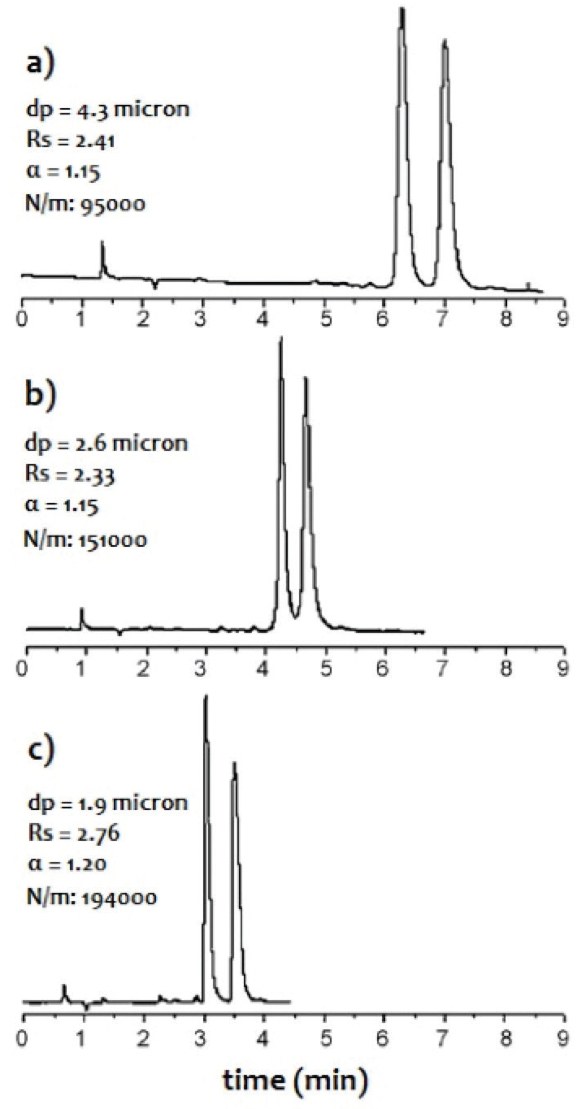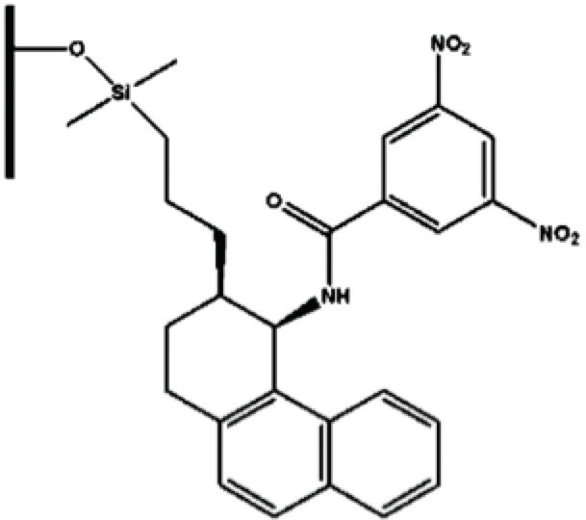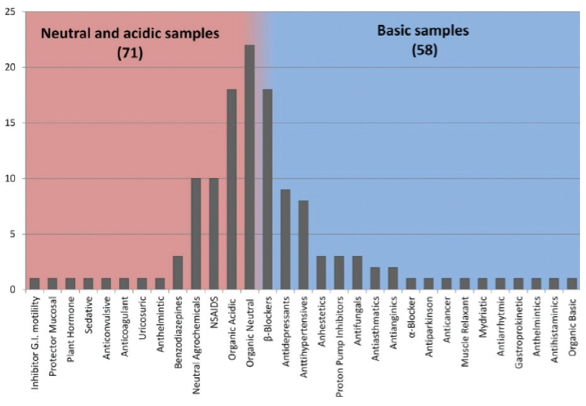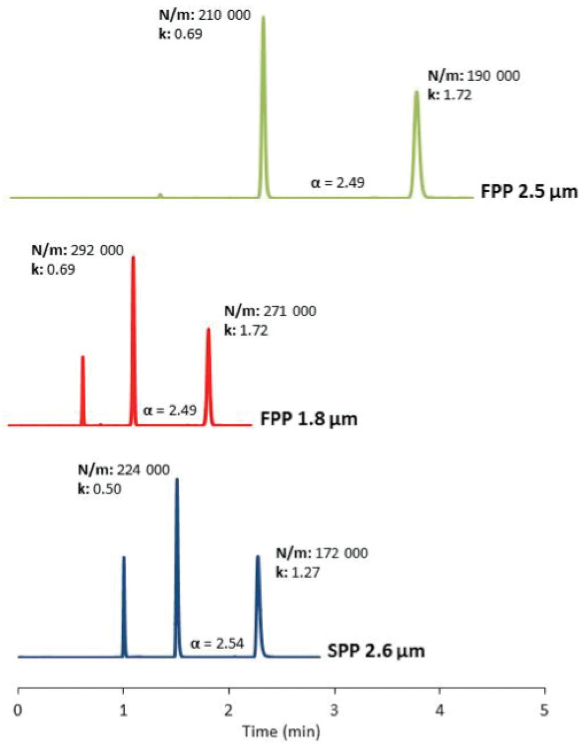Department of Chemistry and Pharmaceutical Sciences
Department of Drug Chemistry and Technology, “Sapienza”
Department of Chemistry and Pharmaceutical Sciences
Department of Drug Chemistry and Technology, “Sapienza”
Department of Chemistry and Pharmaceutical Sciences
Department of Chemistry and Pharmaceutical Sciences
Department of Chemistry and Pharmaceutical Sciences
- University of Ferrara
- University of Rome
Abstract
During the last decade, column manufacturers have put much effort into the design and preparation of materials (e.g., sub-2 micron fully porous and core-shell particles) suitable for highly efficient and fast separations in ultra high-performance liquid chromatography (UHPLC). It is a matter of fact that this advancement has so far only partially touched the field of chiral liquid chromatography. This delay has been essentially due to the lack of understanding of mass transfer processes in chiral chromatography, on the one hand, and to practical difficulties in the preparation of small chiral particles. Recently, Pirkle-type chiral stationary phases (CSPs) have been prepared by using both sub-2 micron fully porous and 2.6 micron core-shell silica particles as base materials. This report describes the employment of these CSPs to achieve not only very high performance but also ultrafast (less than one second) chiral separations in different chromatographic modes.
Introduction
In the last decade the field of chiral separations has been affected by a radical transformation. The attention of scientists and manufacturers has indeed moved from the research of novel CSPs with enhanced enantioselectivity to the preparation of new versions of already known CSPs prepared on kinetically highly efficient silica particles, such as the sub-2 micron fully porous particles (FPPs) and the 2.6 micron superficially porous ones (SPPs). Pressing requirements especially by pharmaceutical and medicinal industries – e.g., for the screening of large libraries of chiral molecules or, in general, for high-throughput analysis1 – have indeed pushed towards the development of increasingly faster and efficient chiral separations, which could not be achieved on CSPs developed on typical 3-5 micron FPPs.
This new trend has had a tremendous impact on the analysis time. If indeed, until only ten years ago, several tens of minutes were the standard time required to perform chiral separations,2 tod the scenario has completely changed.3 Many examples of chiral separations performed in a few minutes, or even on sub-minute scale, have been reported thanks to the use of the above mentioned silica particles, be they FPPs4, 5 or SPPs.6,7,8,9 This report describes the employment of novel Pirkle-type Whelk-O1 CSPs in ultra-high performance chiral chromatography (UHPLC) for fast and ultra-fast (less than one second) enantioseparations.

Pirkle-Type CSPs For Ultra-High Performance, Ultra-Fast Enantioseparations
Pirkle-type (even referred to generically as brush-type) CSPs were the first ones employed for the preparation of sub 2 micron chiral particles.10 The choice of this selector for the transition from enantioselective high performance liquid chromatography (e-HPLC) to e-UHPLC finds its rationale in the ease to prepare sub-2 micron particles (absence of particle aggregation and clogging during their synthesis)10 and on the supposed fast mass transfer kinetics proper of CSPs based on this class of selectors9.
The first Pirkle type eUHPLC CSP was prepared in 2010 by Cancelliere et al. They functionalized 1.9 micron FPPs with DACH-DNB selector.5 Kinetic performance of columns packed with this CSP was compared to that of columns packed with 4.3 and 2.6 micron DACH-DNB FPPs. The sub-2 micron column displayed both significant efficiency gain and reduced analysis times (see Figure 1) with respect of the other two particle formats by simultaneously maintaining comparable selectivity and improving the resolution (due to higher efficiency).
 Figure 1. Chromatograms showing the separations of enantiomers of 2-methoxyphenyl methyl sulfoxide on columns packed with DACH-DNB FPPs at constant L/dp (length/particle diameter) ratio: a) 150×4.1 mm, dp = 4.3 micron, L/dp = 35; b) 100×4.1 mm; dp = 2.6 micron, L/dp = 38; c) 75×4.1 mm; dp = 1.9 micron, L/dp = 39. Resolution (Rs), selectivity (α) and efficiency (number of theoretical plates per meter, N/m) are reported close to each chromatogram. Adapted from ref. 5 (D. Kotoni et al., Anal. Chem. 2012;84:6805- 6813). Copyright (2012) American Chemical Society.
Figure 1. Chromatograms showing the separations of enantiomers of 2-methoxyphenyl methyl sulfoxide on columns packed with DACH-DNB FPPs at constant L/dp (length/particle diameter) ratio: a) 150×4.1 mm, dp = 4.3 micron, L/dp = 35; b) 100×4.1 mm; dp = 2.6 micron, L/dp = 38; c) 75×4.1 mm; dp = 1.9 micron, L/dp = 39. Resolution (Rs), selectivity (α) and efficiency (number of theoretical plates per meter, N/m) are reported close to each chromatogram. Adapted from ref. 5 (D. Kotoni et al., Anal. Chem. 2012;84:6805- 6813). Copyright (2012) American Chemical Society.A few years later, the Whelk-O1 chiral selector (see Figure 2), probably the most popular and versatile one among the Pirkle-types, was employed to functionalize sub 2-micron FPP.4,8,11,12
 Figure 2. Schematic structure of (R,R)-Whelk-O1 CSP.
Figure 2. Schematic structure of (R,R)-Whelk-O1 CSP.Whelk-O1 selector is well known for being able to discriminate a broad range of chiral compounds and for its stability at high pressure and temperature. Whelk-O1 CSPs can be used in normal phase (NP), polar organic mode (POM), reversed-phase (RP) and supercritical fluid chromatography (SFC) conditions. As shown as an example in Figure 3, this CSP allowed to achieve excellent chromatographic performance, with very large resolution and very symmetrical and thin peak shapes in ultrafast separations.4
 Figure 3. Examples of ultrafast enantioseparations performed on a 50 × 4.6 mm ID column packed with sub-2 micron Whelk-O1 particles. Acenaphtenol (a) and benzoin (b) separated in NP mode (mobile phase: hexane/ethanol 70:30 (% v/v), flow rate: 2 mL/min); flurbiprofen (c) and naproxen (d) separated in POM (mobile phase: acetonitrile + 0.2% acetic acid + 0.07% dietilamine (%v/v), flow rate: 2.5 mL/min). Selectivity (α) and resolution (Rs) are indicated close to each chromatogram. Reprinted with permission from ref. 4.
Figure 3. Examples of ultrafast enantioseparations performed on a 50 × 4.6 mm ID column packed with sub-2 micron Whelk-O1 particles. Acenaphtenol (a) and benzoin (b) separated in NP mode (mobile phase: hexane/ethanol 70:30 (% v/v), flow rate: 2 mL/min); flurbiprofen (c) and naproxen (d) separated in POM (mobile phase: acetonitrile + 0.2% acetic acid + 0.07% dietilamine (%v/v), flow rate: 2.5 mL/min). Selectivity (α) and resolution (Rs) are indicated close to each chromatogram. Reprinted with permission from ref. 4.Short columns (5 cm) packed with sub 2-micron Whelk-O1 FPPs were successfully employed for the fast screening of a library of 129 racemic compounds (Figure 4) with significantly different physico-chemical properties (including organic acids, β-blockers, antidepressants, agrochemicals) in SFC.2
 Figure 4. Classification of chiral compounds separated on a sub-2micron Whelk-O1 column in SFC. Reprinted with permission from Ref. 2.
Figure 4. Classification of chiral compounds separated on a sub-2micron Whelk-O1 column in SFC. Reprinted with permission from Ref. 2.The overall screening was carried out in less than 24 hours under fast gradient elution (9 minute total analysis time, including column reconditioning) by using a mixture of CO2/methanol as the mobile phase. The sub-2 micron fully porous Whelk-O1 CSP was found to be able to resolve even basic racemic mixtures, which are not traditionally easily separated on Whelk-O1 CSPs prepared on larger particles. Under NP conditions, these new columns exhibited kinetic performance comparable to those typical of achiral separations with efficiency in the order of 300,000 plates/meter (Figure 5).
 Figure 5. Chromatograms showing the separation of transstilbene oxide enantiomers on the three columns at the flow rate corresponding to the minimum of the van Deemter curve (from top to bottom, respectively, 1.2, 1.8 and 1.5 mL/min). CCl4 was used as dead volume marker. For each peak retention factor (k) and efficiency as number of theoretical plates per meter (N/m) are reported.
Figure 5. Chromatograms showing the separation of transstilbene oxide enantiomers on the three columns at the flow rate corresponding to the minimum of the van Deemter curve (from top to bottom, respectively, 1.2, 1.8 and 1.5 mL/min). CCl4 was used as dead volume marker. For each peak retention factor (k) and efficiency as number of theoretical plates per meter (N/m) are reported.These efficiencies were even difficult to imagine only a few years ago in chiral chromatography. In 2016, Whelk-O1 chiral selector was employed also for the preparation of 2.6 micron SPPs.8
With Whelk-O1 CSPs prepared on these highly performance particles, extraordinary results in terms of ultrafast enantioseparations were obtained thanks to the use of short columns (1 cm) and high flow rates. For instance, by employing 10 × 0.3 cm (length × I.D.) columns at a flow rate of 8 mL/min, the two enantiomers of trans-stilbene oxide were separated in less than one second on both the SPP and FPP columns (see Figure 6).
 Figure 6. Ultrafast enantioseparation of trans-stilbene oxide enantiomers on 10 × 3.0 mm columns packed with Whelk-O1 SPP 2.6 μm (left) and Whelk-O1 FPP 1.8 μm (right). Adapted with permission from ref. 9 with permission from The Royal Society of Chemistry.
Figure 6. Ultrafast enantioseparation of trans-stilbene oxide enantiomers on 10 × 3.0 mm columns packed with Whelk-O1 SPP 2.6 μm (left) and Whelk-O1 FPP 1.8 μm (right). Adapted with permission from ref. 9 with permission from The Royal Society of Chemistry.Conclusions
The transition from traditional e-HPLC to e-UHPLC has started and will continue in the future.
Whelk-O1 Pirkle-type chiral selectors definitely represent one of the successful examples of the enormous advantages that can be achieved, also in the field of chiral separations, by employing small silica particles with enhanced characteristics in terms of mass transfer. The issues in the preparation of small chiral particles seem to be overtaken. On the other hand, slurry packing of small particles (including core-shell ones)13 has tremendously improved in the last years to the point that modern techniques of packing allow to obtain very efficient packed beds. Nowadays, CSPs able to perform as efficiently as typical reversed-phase stationary phases (with efficiency in the order of 300,000 theoretical plates per meter or more) have been already prepared and tested in laboratory, even if they are not yet commercially available. These phases can be operated in very different chromatographic modes and they are suitable for very high-pressure regimes. The future of chiral separations via liquid chromatography is strictly connected to the development of these new CSPs and will be characterized by very fast and efficient separations on columns of reduced length and diameter.
References
- Mangelings D, Heyden YV. Screening approaches for chiral separations. In: E. Grushka NG, ed. Advances in chromatography. Vol 46. New York: CRC Press; 2007.
- Sciascera L, Ismail OH, Ciogli A, et al. Expanding the potential of chiral chromatography for high-throughput screening of large compound libraries by means of sub-2 um Whelk-O1 stationary phase in supercritical fluid conditions. J. Chromatogr. A. 2015;1383:160-168.
- Patel DC, Breitbach ZS, Wahab MF, Barhate CL, Armstrong DW. Gone in seconds: praxis, performance, and peculiarities of ultrafast chiral liquid chromatography with superficially porous particles. Anal. Chem. 2015;87:9137–9148.
- Kotoni D, Ciogli A, Molinaro C, et al. Introducing enantioselective Ultrahigh-Pressure Liquid Chromatography (eUHPLC): Theoretical inspections and ultrafast separations on a new sub-2um Whelk-O1 stationary phase. Anal. Chem. 2012;84:6805-6813.
- Cancelliere G, Ciogli A, D’Acquarica I, et al. Transition from enantioselective high performance to ultra-high performance liquid chromatography: A case study of a brushtype chiral stationary phase based on sub-5-micron to sub-2-micron silica particles. J. Chromatogr. A. 2010;1217:990-999.
- Wahab MF, Wimalasinghe RM, Wang Y, Barhate CL, Patel DC, Armstrong DW. Salient subsecond separations. Anal. Chem. 2016;88:8821-8826.
- Wimalasinghe RM, Weatherly CA, Breitbach ZS, Armstrong DW. Hydroxypropyl beta cyclodextrin bonded superficially porous particle-based HILIC stationary phases. J. Liq. Chromatogr. Relat. Technol. 2016;39:459-464.
- Ismail OH, Pasti L, Ciogli A, et al. Pirkle-type chiral stationary phase on core-shell and fully porous particles: Are superficially porous particles always the better choice toward ultrafast high-performance enantioseparations? J. Chromatogr. A. 2016;1466:96-104.
- Catani M, Ismail OH, Gasparrini F, et al. Recent advancements and future directions of superficially porous chiral stationary phases for ultrafast high-performance enantioseparations. Analyst. 2017;142:555-566.
- Cavazzini A, Marchetti N, Guzzinati R, et al. Enantioseparation by ultra-high performance liquid chromatography. TrAC, Trends Anal. Chem. 2014;63:95-103.
- Kotoni D, Ciogli A, D’Acquarica I, et al. Enantioselective ultra-high and high performance liquid chromatography: A comparative study of columns based on the Whelk-O1 selector. J. Chromatogr. A. 2012;1269:226-241.
- Gasparrini F, Ciogli A, Pierini M, et al. The Evolution of Chiral Stationary Phases from HPLC to UHPLC. LC/GC Eur. 2014;27:128-137.
- Patel DC, Breitbach ZS, Yu J, Nguyen KA, Armstrong DW. Quinine bonded to superficially porous particles for high-efficiency and ultrafast liquid and supercritical fluid chromatography. Anal. Chim. Acta. 2017;963:164-174.